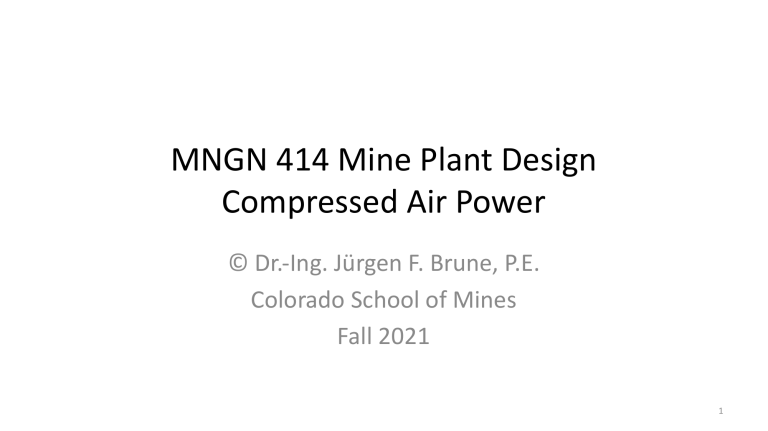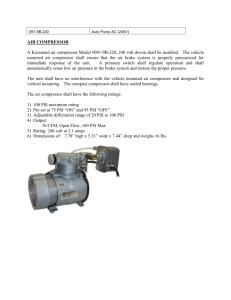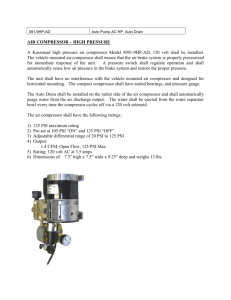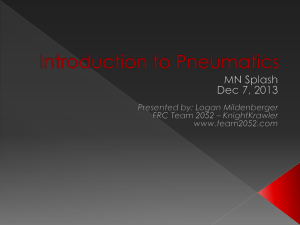
MNGN 414 Mine Plant Design Compressed Air Power © Dr.-Ing. Jürgen F. Brune, P.E. Colorado School of Mines Fall 2021 1 References • Bise CJ [2003]: Mining Engineering Analysis, 2nd ed., SME, Littleton CO, p. 145 – 153 • Lowrie RL [2002]: SME Mining Reference Handbook, SME 2002, p. 283 – 286 • Compressor Manufacturer’s Handbooks, for example: Compressed Air and Gas Data, by Ingersoll Rand, 2nd. ed., 1971 • SME Mining Engineering Handbook 2 Student Learning Outcomes Course Level: • Identify and design simple compressed air applications for the mining industry Lecture Level: • Calculate basic design parameters for compressed air networks • Select suitable compressors and compressed air equipment for mining applications 3 Compressed Air Pros and Cons Pros: • Easier to install than electrical equipment. Often used in small and artisanal mines • Useful where no electric power available • Non-electric, can be used in coal mine returns and bleeders • Similarly versatile as hydraulics, but without the fluid spills • Simple and robust, usually safe • Easily adjustable (pressure, speed, flow) Cons: • Poor energy efficiency. Still, 50 x more efficient than muscle power • Heavier than comparable electric equipment • Noisy (turbines, jackleg drills, impact wrenches) • Dusty: Air exhaust stirs up dust 4 Types of Compressors • Positive Displacement: Intermittent Flow – Reciprocating (Piston-Type, pulsating) – Rotary (Roots-type, screw-type and others, continuous) • Continuous Flow – Centrifugal – Axial Flow – Ejector 5 Reciprocating Compressor • Multiple stages (2-4) for higher pressures and better efficiency • Intercoolers improve efficiency to save power • Up to 60,000 psi (400 MPa) • Also used for vacuum pumps 6 Roots and Screw-Type Compressors 7 Axial-Flow Compressor • Multiple stages • High air volume • Usually <100 psi (0.7 MPa), some up to 500 psi (3.5 Mpa) • Used in jet engines 8 Centrifugal Compressors (Blowers) • • • • Similar to centrifugal pumps Single or multi-stage Used as exhaust turbochargers (high rpm, single stage) Up to 5,000 psi (34 Mpa) 9 Absolute and Gauge Pressure • Mine operators use pressure gauges to determine compressed air performance • Gas laws are based on absolute pressure – that’s why most compressed air calculations are based on absolute pressure • Atmospheric pressure changes with altitude pa = pb + pg Where: pa = Absolute pressure [psia or kPaa] pb = Barometric or atmospheric pressure [psi or kPa] pg = Gauge pressure [psig and kPag] 10 Air Pressure at Elevation, SI Simplified Altitude Formula (in SI units) log p2a = log p1a – 0.0000515 h Where: p1a = absolute pressure at elevation 1 [Pa or kPa] p2a = absolute pressure at elevation 2 [Pa or kPa] h = elevation difference [m] log is the decadic or common logarithm Good to know: The absolute pressure at sea level, pb = 100 kPa 11 Air Pressure at Elevation (Imperial) Simplified Altitude Formula (in imperial units) log p2a = log p1a – 0.0000157 h Where: p1a = absolute pressure at elevation 1, psi p2a = absolute pressure at elevation 2, psi h = elevation difference, ft. log is the decadic or common logarithm Good to know: The absolute pressure at sea level, pb = 14.7 psi 12 Sample Problem, Pressures and Altitude A compressor is operated at 6000 ft (1800 m) above sea level. The mine workings are at 3000 ft (900 m) above sea level. The required gauge air pressure at the mine workings is 80 psig (540 kPa). What should be the gauge air pressure at the compressor location, in psig? 13 Solution The atmospheric pressure at sea level is 14.7 psi. log (p6000atm) = log (14.7) – 0.0000157 * (6000) = 1.07 p6000atm = 101.07 = 11.7 psi log (p3000atm) = log (14.7) – 0.0000157 * (3000) = 1.12 p3000atm = 101.12 = 13.2 psi Required absolute pressure at 3000 ft => 80 + 13.2 = 93.2 psia Required pressure at compressor (= gage pressure): log (p6000a) = log (93.2) - 0.0000157 (3000) = 1.92 p6000a = 83.7 psia p6000g = 83.7 – 11.7 = 72.0 psig 14 Solution, SI Units The atmospheric pressure at sea level is 100 kPa. log (p1800atm) = log (100) – 0.0000515 * (1800) = 1.91 p1830atm = 101.91 = 81.2 kPa log (p900atm) = log (100) – 0.0000515 * (900) = 1.95 p915atm = 101.95 = 89.1 kPa Required absolute pressure at 900 m => 540 + 89 = 630 kPaa Required pressure at compressor (= gage pressure): log (p1800a) = log (630) – 0.000515 (900) = 2.75 p1800a = 102.75 = 562 kPaa p1800g = 562 – 81 = 481 kPag 15 Compressed Air Line Losses • Similar to water, the pressure loss in compressed air lines increases with line length • Line friction depends on the state of flow (laminar or turbulent) – same Moody diagram that we discussed in connection with pumps. • Often, compressed air lines, valves, fittings, compressors and air-driven equipment experience leakage that results in loss of power and wasted energy. 16 General Line Loss Equation (Darcy, SI) Δp = p2a – p1a = f * ρ/2 * (L + Le) * v2 / d [Pa] Where f = friction factor [ ], function of Reynolds no. and pipe roughness, use Moody chart (same as for pumps). ρ = air density at flow conditions [kg/m3] L = pipe length [m], Le = equivalent length for elbows, tees, valves etc. – see pumps v = flow velocity [m/s] d = pipe diameter [m] Reynolds Number Re = v * dh / ν ν = kinematic viscosity [m2/s] dh = hydraulic diameter = d [m] Note that the Darcy formula has limitations in its applicability to compressed gases 17 Moody Diagram λ=f 18 Empirical Line Loss for Compressed Air Δp = 1,480 * Q1.85 * (L + Le) * / (d5 * pa) [Pa] Where Q = quantity of free air (atmospheric) [m3/s] L = length [m]; Le = equivalent length p = initial, absolute pressure [Pa] d = pipe diameter [m] pa = absolute initial pressure 19 Practical Line Loss for Compressed Air p1a2 – p2a2 = Q2 * L / (2,000 D5) Δp = p1a – p2a Where: p1a, p2a = absolute pressures at start and end, psia Δp = pressure drop between points p1 and p2 Q = quantity, cfm of free air L = length of pipeline, ft. D = diameter of pipe, inches Note: This equation is only for estimating purposes 20 Sample Problem, Line Loss 4200 ft3/min of free air are to be delivered at 80 psig over a distance of 2,000 ft. through a 6 in. diameter pipe. Assume that the compressor and the mine workings are at sea level elevation. 1. What is the required absolute pressure at the compressor? 2. What is the line pressure loss? Use both the practical and the empirical formulas 21 Practical Formula Solution Always work in absolute pressures! p2a = 80 + 14.7 = 94.7 psia required at the drill site Line loss formula: (p1a)2 – (94.7)2 = (4,200)2 * 2,000 / (2,000 * 65) (p1a)2 = 11,200 so p1a = (11,200)0.5 = 106 psia Answers: 1. p1a = 106 psia required at the compressor 2. Line loss: 106 – 94.7 = 11.3 psi. 22 Empirical Formula Solution (SI units) Convert to base SI units: Q = 4,200 cfm = 1.98 m3/s L = 2,000 ft = 610 m d = 6 in. = 0.152 m p2a = 80 + 14.7 = 94.7 psi = 653,000 Pa (absolute!) Δp = 1,480 * Q1.85 * L * / (d5 * pa) = 1,480 * (1.98)1.85 * 610 / (0.1525 * 653,000) = 60,300 Pa = 8.8 psi Required at the compressor: 94.7 + 8.8 = 104 psia or 89.3 psig 23 Compressed Air Equipment • • • • • • • • • • Percussive drills (jackleg and jumbo) Jackhammers Rotary drills (coal and soft rock only) Turbines to generate electricity for lights Water pumps, membrane-type Air hoists Overshot muckers Combined air-hydraulic equipment Air jacks, flat jacks for lifting Shop tools: Impact wrenches, car lifts 24 Jackleg Drill MWDrill 25 Jackhammer H Equipment Hire 26 Pneumatic, Rotary Coal Drill Xinhai Topmarko 27 Air Turbine Electric Lights Wolf Company 28 Compressed-Air, Diaphragm Water Pump BPH Pump & Equipment Wikipedia 29 Compressed Air Hoist (“Come-Along”) 30 Compressed Air Hoist (Atlas Copco) 31 Sample Problem, Air Drill A compressed air drill operating at 80 psig requires 114 cfm of free air at sea level. What will be the required air quantity if the drill runs at 100 psi and at sea level? Solution: Q is proportional to the absolute pressures (not the gage pressures). Air pressure at sea level is 14.7 psi (good to remember). Q2 = Q1 * Pa2 / Pa1 = 114 * (100 + 14.7) / (80 + 14.7) Q2 = 138 cfm 32 Compressor Sizing Laws Similar to pump and fan laws: Change in rpm: Speed ratio rpm2 / rpm1 = N Q2 / Q1 = N H2 / H1 = N2 BHP2 / BHP1 = N3 33 Sample Problem, Compressed Air A maintenance shop requires a 6,000-scfm supply of compressed air at 20 psig (sea level). A used centrifugal blower has been found and the operations department has been instructed to double its speed to obtain the required supply volume. Name plate data on the blower are as follows: Volume = 3,000 scfm Pressure = 20 psig Speed = 1,200 rpm Power = 15 hp Efficiency: 60% a) What horsepower (hp) is required to produce the required 6,000-scfm output volume? b) What is the pressure (psig) that the modified blower produces? 34 Solutions According to compressor laws, BHP varies with the cube of the speed ratio. Speed ratio N = 2,400 / 1,200 = 2 a) Horsepower is proportional to N3 Horsepower = 15 hp x 23 = 120 hp b) Pressure is proportional to N2 Pressure = 20 psig x 22 = 80 psig 35 Compressor CFM Determination Start with a tank pressure pg1 and determine the time t when the tank reaches the pressure pg2. Q = 0.536 * V * (pg2 – pg1) / t Where: Q = quantity [actual cfm] V = tank volume [gal] pg = pressure [psig] t = time to fill [s] 36 Example A compressor tank has a volume V = 100 ft3 and is pumped up from empty (pg1 = 0) to pg2 = 120 psi in 8 minutes. Determine the compressor output in standard cfm (SCFM). Solution: 100 ft3 * 7.48 = 748 gal 8 minutes = 480 s Q = 0.536 * V * p / t = 748 * 0.536 * (120 – 0) / 480 = 100 cfm 37 Compressor Horsepower For adiabatic conditions (i.e., without heat loss): BHP = 144 * N * p1a * Q * k * [(p2a / p1a)(k - 1)/(N*k) – 1] / ( 33000 * (k - 1) * η) where BHP = brake horsepower N = number of compression stages [ ] k = 1.41 = adiabatic expansion coefficient for air [ ] P1a = absolute initial atmospheric pressure [psia] P2a = absolute final pressure after compression [psia] Q = volume of air at atmospheric pressure [cfm] η = compressor efficiency, typically 0.8 to 0.85 From https://www.engineeringtoolbox.com/horsepower-compressed-air-d_1363.html 38 Edgar Mine Compressor Data 39 Compressor Horsepower Using the data above for the Edgar Mine compressor, with η = 0.8: BHP = 144 * 2 * 10.9 * 660 * 1.41 * [(136/10.9)(0.41)/(2.82) – 1] / (33000 * 0.41 * 0.8) = 120 hp Simplified, from SME Mining Engineering Handbook, 2nd ed.: BHP = 0.154 * N * Q * [(p2a / p1a)(0.283/N) – 1] / η Using Edgar data, BHP = 0.154 * 2 * 660 * [(136/10.9)(0.283/2) – 1] / 0.8 = 109 hp. Note that this equation does not consider the site barometric pressure p1a as does the earlier formula. Using Nomograph (next slide): 100 psi requires 0.145 hp/cfm. 660 cfm requires ~96 hp. At an efficiency of 0.8, this is equal to 120 BHP motor power required. 40 Compressor Horsepower Nomograph 41



